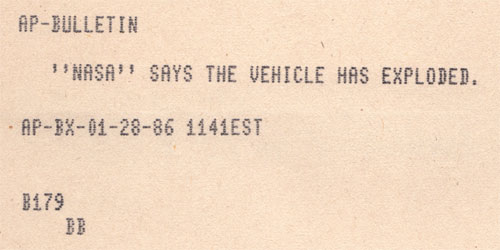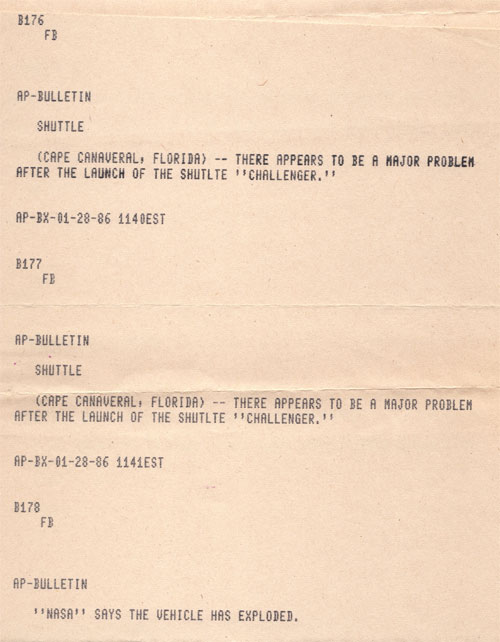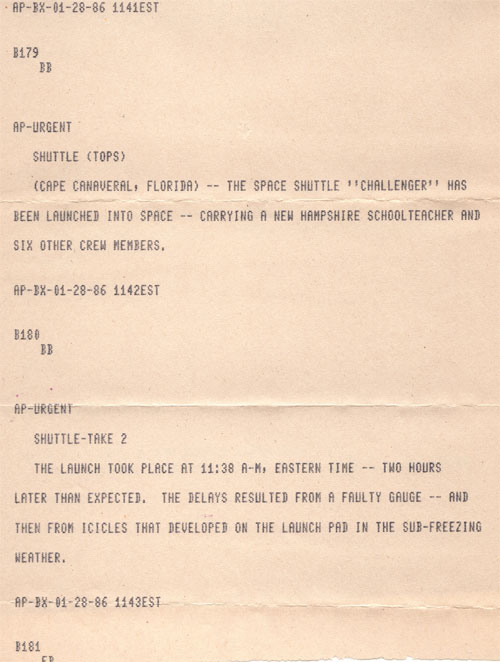Remembering Covering The Space Shuttle Challenger Explosion On College Radio

When we think of major national and international events that occur in our lifetime, we also remember the impact of it on ourselves – where we were, what we were doing and how we felt as it unfolded. As today is the anniversary of the explosion of the Space Shuttle Challenger, I would like to share my day after first hearing about it and how I remember it today.
Twenty-nine years ago I was in the production studio of my college radio station, WNEK-FM in Springfield, MA, preparing for my first newscast of the semester. Where our newscasts were far from anything that would win a local Emmy and could easily be called “rip-and-read” reports, we always did a professional (or as professional as we could) job at presenting world and local news on the air. I was sitting at the console board recording audio clips from a network audio feed we had to accompany the stories I had collected thus far from the Associated Press teletype printer, or commonly referred to as the AP machine.
I was well aware of the Space Shuttle Challenger launch, especially as the crew included Christa McAuliffe, a schoolteacher from the neighboring state of New Hampshire, around whom there was a lot of buzz for her being on board. I listened for the reports from the audio feed and there was to be one for the Challenger launch, so I was prepared to “cart it up,” or record it on a tape cartridge to play along with what I was to read from the AP machine story.
As I was listening and getting ready to record, the audio feed cut out. I recall calling out something like, “what the hell?” and then I heard the bells on the AP machine ringing as I had never heard them ring before. The AP machine, which was nothing more than a dot-matrix printer that printed on rolled paper, would sound bells when there was urgent news. In the few months on the college radio station I would hear bells ring, maybe once or twice, but not non-stop, or what it seemed. As I and others went to look at what was printing out, we saw initial stories about the launch of Challenger, then that “there appears to be a major problem after the launch of the shuttle ‘Challenger.’”, which was then followed with what is pictured above, “’NASA’ says the vehicle has exploded.’, which was then followed by messages about the successful launch of the shuttle, which apparently were written and sent before the explosion message.
My memory of this is amplified by the fact that for some reason I kept the initial news feeds that came off the AP machine on the explosion. Typically news stories are ripped, read and then discarded (thus, rip-and-read). I kept about 2 feet of the scrolled paper, which included the above alert, and the complete scanned images of the entire scroll are at the end of this post. Note the above alert went across 2 scanned images, thus I made this composite from both.
Following these alerts, there was a lot of activity in the radio station, which was located in our campus center. As there were no TVs in the campus center, we became the primary source for information on the explosion, and we even got the radio signal piped in over the campus center PA system. What was to become a 10-minute newscast at noontime engulfed more time from music programming and more people as well, as we were reporting on what was coming off the AP machine, as well as the network audio feed, which we had cut to directly, unedited, for a portion of time.
For most all of us, in our late teens to early 20’s, we had really never lived through a large national tragedy like this. Then add to it our role in broadcasting it. Where we tried to not be chaotic and somewhat organized about it, for most of us we were making up our approach as we went along. There was plenty of stepping on each other’s toes and voices and literally bumping into each other as we moved around our small studio space. The doors from the broadcast studio and lobby were all open – a major faux pas – as station members and students and faculty were coming and going to hear what was transpiring.
As the day went on, TVs were brought into the campus center, allowing all of us who had only heard about the explosion to actually see it. I remember being in awe as I saw the video played over and over and over and over. I also recall a mix of emotions, from tragedy and sadness, to thinking of all the school children who were watching this live, to why it happened after so many successful launches. The last loss of life for NASA happened before I was born, and after growing up seeing other launches, moon landings and successful returns to earth, this was something entirely new to think about.
Nearly three decades later, we know about O-rings, known engineering flaws, the loss of another shuttle vehicle and the remaining ones are now on their way to museums. Then President Ronald Reagan’s speech to the nation was perfect for the moment then and reflecting on it today, and you can view it here on YouTube. I share the images and memory of this as the these types of stories need to be told, not just the headlines but what happened behind and around them, as these show the complete fabric of our society.


This is from The Hot Iron, a journal on business and technology by Mike Maddaloni.
Did you enjoy this? Subscribe to The Hot Iron by RSS/XML feed or Read by Email.
Announcements • Diversions • (2) Comments • Permalink



